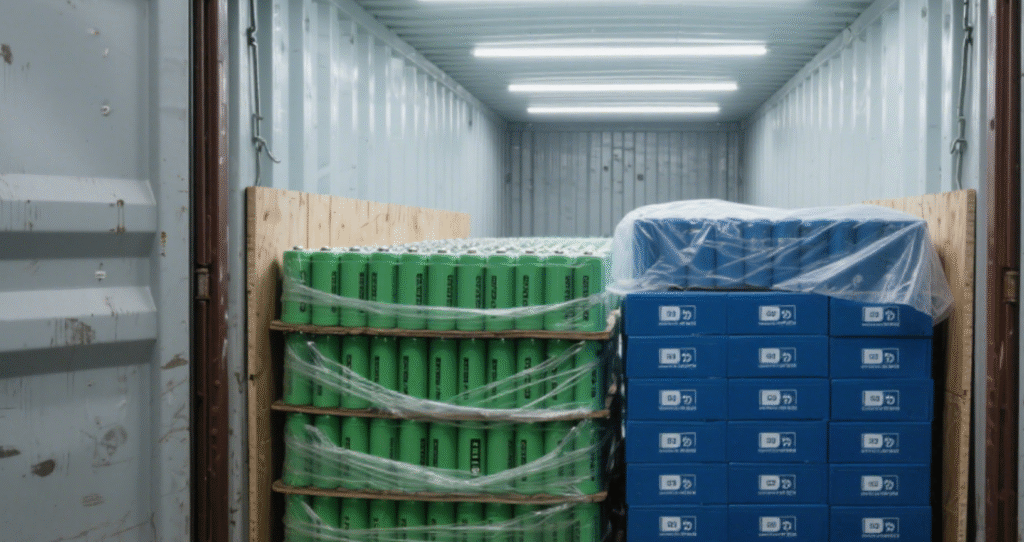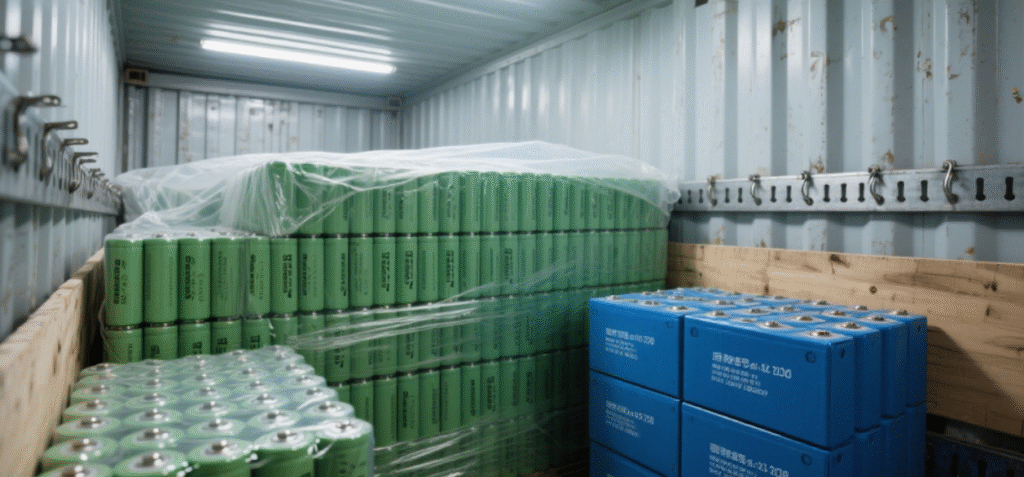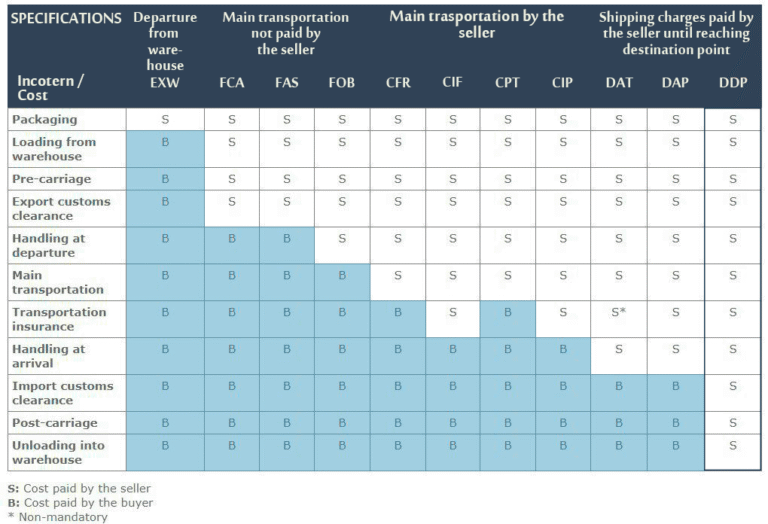Are all batteries considered hazardous goods? These types can be shipped as general cargo!
I. Hazardous or Non-Hazardous? Battery Classification Comes First
Before discussing the transport classification of batteries, we must clarify one key question: Which types of batteries are classified as dangerous goods, and which are not?
In fact, the first step in making this judgment lies in identifying the type of battery. Due to differences in chemical composition, energy density, and other factors, different types of batteries pose very different levels of risk during transportation.

(1) These Batteries Are “Safe Players” — Can Be Shipped as General Cargo
Within the battery family, some types are known as “safe players” — such as alkaline batteries, zinc-manganese batteries, carbon-zinc batteries, and standard dry cell batteries. These are commonly found in everyday items like clocks, remote controls, and flashlights, serving as a reliable power source.
From a transportation perspective, these batteries are considered low-risk and, in most cases, do not require declaration as dangerous goods. However, it’s important to note that although they are typically “well-behaved,” whether they can officially be shipped as general cargo still depends on a transport identification report. This report provides scientific data and test results to prove the battery’s safety during transport.
(2) These Batteries Carry Risks — Special Handling Required
Not all batteries are this “worry-free.” Some types, such as lithium batteries, lead-acid batteries, and nickel-metal hydride (NiMH) batteries, require special attention due to their inherent risks.
1. Lithium Batteries
Lithium batteries are widely used today — from smartphones and laptops to electric vehicles. However, they are classified as Class 9 Dangerous Goods in transportation because the chemicals inside can become unstable under certain conditions like impact, high temperatures, or short circuits, potentially causing fire or even explosions.
For shipping lithium batteries, you must provide:
- MSDS (Material Safety Data Sheet)
- Transport Identification Report
- UN38.3 Test Report
That said, there are “special exceptions”:
If individual lithium cells are under 20Wh or battery packs are under 100Wh, and they meet the packaging requirements of Packing Instruction P903, they can be accepted as general cargo.
Still, the outer packaging must display the lithium battery label, to alert handlers of the contents’ special nature.
2. Lead-Acid Batteries
Commonly used in cars and UPS systems, lead-acid batteries provide stable power support. However, they contain sulfuric acid and other electrolytes that are corrosive, posing risks during transport.
An MSDS is required for shipping.
If the battery meets the requirements of IMDG Code Special Provision SP238, it can be treated as general cargo.
This special clause acts like a “green light” for shipping lead-acid batteries — but only if all detailed conditions, such as packaging and battery state, are strictly followed.
3. Nickel-Metal Hydride (NiMH) Batteries
Commonly found in small electronics like early digital cameras and MP3 players, NiMH batteries have more flexible shipping requirements.
When transporting, you need to provide:
- MSDS
- Photos of the product packaging
Authorities will review the documentation to determine whether the battery can be accepted as general cargo.
It’s also crucial to clearly state the form in which the batteries are shipped:
- Loose cells
- Battery packs
- Packed together with equipment
These details are critical for accurately assessing the transport risk.

II.Battery-Powered Products ≠ Dangerous Goods!
Classification Depends on the Battery Type
Once we understand the basic classifications of batteries, it’s time to look at products powered by batteries. These battery-powered items often cause confusion in logistics — are they considered dangerous goods or not?
The answer isn’t absolute; just like with standalone batteries, the classification depends on the type of battery they contain.
1. Products with Lithium Batteries:
Most Are Classified as Class 9 Dangerous Goods
Lithium batteries have become the go-to power source for many electronic products due to their high energy density and long life cycles. From smartphones and laptops to children’s toys, many devices either have built-in lithium batteries or use lithium alloy button cells.
In the transportation field, products containing lithium batteries are mostly classified as Class 9 Dangerous Goods. This is because the active chemical components in lithium batteries can become unstable under certain extreme conditions — such as strong impact, high temperatures, or short circuits. These conditions may lead to thermal runaway, which can cause fires or even explosions, posing serious safety risks during shipment.
2. Products with Dry Batteries:
Mostly Safe, Some Require Extra Attention
Dry batteries are common in small, low-power devices such as clocks, remote controls, flashlights, and toys. In most cases, dry batteries are stable and not classified as dangerous goods.
However, a small portion of dry batteries, due to their unique chemical properties, may fall under Class 4 (flammable solids, substances liable to spontaneous combustion, or substances which emit flammable gases when in contact with water) or Class 8 (corrosive substances).
For example, dry batteries containing mercury or other hazardous substances may leak and pose risks to both human health and the environment. Thus, whether a product with dry batteries qualifies as dangerous goods should be assessed based on the specific battery type and confirmed through professional transport classification reports.
3. Products with Wet Batteries:
Mostly Classified as Class 9 Dangerous Goods
Wet batteries play an essential role in fields such as automotive and industrial machinery. Devices like car battery chargers or floor polishers often contain wet batteries.
These batteries typically contain corrosive acids or alkaline substances, which makes them risky to transport. As a result, they are usually classified as Class 9 Dangerous Goods.
Take the common lead-acid battery used in vehicles, for example — the sulfuric acid electrolyte inside is highly corrosive. If improperly packaged and leakage occurs during transport, it can damage shipping equipment and severely pollute the surrounding environment.
Therefore, when shipping products containing wet batteries, special attention must be paid to corrosion-resistant and leak-proof packaging to ensure transportation safety.
III.Quick Reference Table: 27 Types of “Battery-Related Dangerous Goods” — Check Against UN Numbers
For detailed form, please click
IV. Full Procedure for Shipping Non-Hazardous Batteries
Documentation, Packaging, and Declaration – All Steps at a Glance
Once it’s confirmed whether the batteries are classified as hazardous or not — and their corresponding UN numbers are identified — it’s time to proceed with the actual shipping process.
Although non-hazardous batteries are relatively easier to ship, there are still strict procedures and requirements that must be followed. Only when each step is handled correctly can the shipment move forward smoothly and compliantly.
(1) Document Preparation:
Provide Documentation Based on Battery Type
1. For Non-Hazardous Batteries
Batteries such as alkaline, zinc-manganese, carbon-zinc, and standard dry cell batteries typically do not require an MSDS.
However, a Transport Identification Report is essential to verify that they qualify for general cargo transport. This report acts as a “passport” for the shipment of non-dangerous batteries.
The report must be issued by a certified testing agency, which evaluates the battery’s physical and chemical properties and assesses whether the product meets safety standards for general cargo transport.
When applying for this report, detailed battery information must be provided — such as battery type, specifications, and chemical composition — to allow for accurate risk assessment.
2. For Special-Handling Batteries
Batteries like lithium batteries, lead-acid batteries, and nickel-metal hydride (NiMH) batteries require more complex documentation.
In addition to a Transport Identification Report, you must also prepare an MSDS (Material Safety Data Sheet). The MSDS outlines critical information such as the battery’s physical/chemical characteristics, potential health hazards, and safe handling guidelines — it is a required reference during transport.
For lithium batteries, a UN38.3 Test Report is also mandatory. This report simulates various extreme transport conditions (e.g. high/low temperatures, vibration, shock, pressure) to ensure the battery can withstand them without risk.
Only batteries that pass the UN38.3 test are deemed safe for transportation.
All documents must:
- Be in compliance with regulations and standards
- Be valid and within the effective date range
Otherwise, the shipment may be delayed or rejected.
(2) Packaging and Labeling:
Compliance Is in the Details
1. Container Requirements
For lithium battery shipments — except for vehicles powered by lithium batteries — containers carrying lithium batteries classified as dangerous goods must follow strict labeling rules.
- Each side and end of the container must display a Class 9 hazard label
- The label must be at least 250mm x 250mm
- The inner border must run parallel to the edge and be set 12.5mm inside
This label serves as a visible warning, alerting handlers that the container holds potentially dangerous lithium batteries.
Additionally, the container must be labeled with the UN number marking, with characters at least 65mm high, ensuring quick identification.
These labels must be:
- Clearly visible, with strong color contrast to the container
- Outlined with solid or dashed borders, if needed, for enhanced visibility in various environments
2. Package-Level Requirements
Each package containing lithium batteries must also meet detailed labeling rules.
- It must show the Proper Shipping Name and the UN number, prefixed by “UN”
- The UN number and “UN” prefix must be at least 12mm high
Depending on the battery’s classification:
- Compliant small batteries under SP188 should display the lithium battery mark only
- Regular lithium batteries must show the Class 9A hazard label
⚠️ Important:
The lithium battery mark and the Class 9A label must not be used on the same package. Only one is allowed, depending on the classification.
These labels act as silent safety guards, reminding handlers and warehouse personnel to treat the packages with caution to prevent accidents from improper handling or storage.
(3) Compliant Declaration:
Never Conceal – Choose Qualified Logistics Partners
The final step in shipping non-hazardous batteries is the declaration process, and compliance is absolutely essential.
You must choose a logistics provider with proper certifications for handling dangerous goods. These professionals act as experienced “transportation experts,” familiar with all relevant regulations and procedures, ensuring your cargo is transported safely and efficiently.
At the same time, you must accurately declare the nature of your goods. Never attempt to conceal a battery’s classification as hazardous in hopes of simplifying the shipping process.
In recent years, incidents caused by misdeclaring dangerous battery shipments have occurred with alarming frequency.
For example, on November 7, 2024, during a joint enforcement operation by the Port and Maritime Safety Authorities, an incident was uncovered in which a consignor falsely declared hazardous lithium batteries as general cargo.
Investigation revealed that the freight forwarder had negligently misdeclared the goods, nearly leading to serious consequences. As a result, the company faced a proposed fine of RMB 100,000 (approx. USD 14,000).
This case serves as a wake-up call:
- Compliant declarations help avoid heavy fines and cargo holds
- More importantly, they ensure the safety of transportation operations
As a responsible freight forwarder, you must:
- Fully understand the nature of your goods before export
- Strictly follow all relevant procedures and compliance standards
Only by doing so can you minimize transport risk and ensure that shipments reach their destinations safely and smoothly.
Conclusion:
Battery shipping is not a one-size-fits-all process.
Accurate classification, proper documentation, compliant packaging and labeling, and choosing qualified logistics partners are key to ensuring smooth export of non-hazardous batteries.
A little more attention before export can greatly reduce risks during transit, helping ensure your goods arrive safely in markets around the world.
If you have any questions, feel free to reach out — we’re always here to help!





